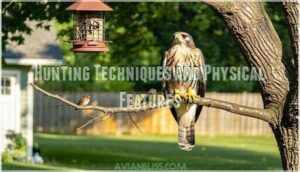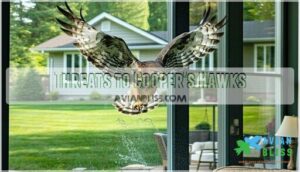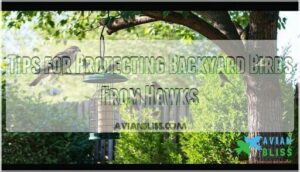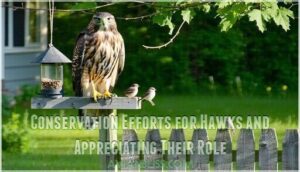This site is supported by our readers. We may earn a commission, at no cost to you, if you purchase through links.

Hawks patrol backyards with bird feeders since they’re like fast-food restaurants for these skilled predators. Your feeder attracts small songbirds, which in turn draws hungry hawks looking for an easy meal.
Trees and perches in your yard provide perfect lookout spots, while open spaces give them room to maneuver during hunts. It’s nature’s food chain playing out in your backyard – you’ve simply become the neighborhood’s hunting hotspot.
Understanding this natural behavior helps you protect your feathered visitors while respecting these magnificent raptors’ ecological role.
Table Of Contents
- Key Takeaways
- Understanding Backyard Hawks
- Cooper’s Hawks: Skilled Hunters of Backyard Birds
- The Role of Hawks in The Ecosystem
- Tips for Protecting Backyard Birds From Hawks
- What to Do When Hawks Won’t Leave
- Attracting Hawks: Intentional or Unintentional?
- Conservation Efforts for Hawks and Appreciating Their Role
- Frequently Asked Questions (FAQs)
- Conclusion
Key Takeaways
- You’ve created prime hunting territory – Your bird feeders attract songbirds, which naturally draw hawks looking for easy prey, turning your backyard into their personal restaurant.
- Hawks play a crucial ecological role – They’re nature’s pest control specialists, maintaining ecosystem balance by controlling rodent populations and removing weak or diseased birds from the gene pool.
- You can protect songbirds without harming hawks – Use covered feeders, provide natural shelter near dense trees or shrubs, and eliminate ground-scattered seed debris that creates vulnerable feeding situations.
- Coexistence is both legal and beneficial – Hawks are federally protected, so you can’t remove them, but their presence indicates a healthy ecosystem and they’ll naturally move on when easier hunting grounds become available elsewhere.
Understanding Backyard Hawks
That hawk circling your yard isn’t lost—it’s found the perfect hunting ground. Urban areas now teem with hawks because suburbia offers an all-you-can-eat buffet.
Your backyard bird feeder isn’t just feeding songbirds—it’s serving up a hawk’s dream menu.
Bird feeders attract songbirds, which draw Cooper’s and sharp-shinned hawks like magnets. These aerial predators have mastered urban adaptations, turning your peaceful backyard into their personal restaurant.
Hawk identification becomes essential when you’re dealing with regular visitors. Cooper’s hawks sport crimson eyes and streaked chests, while sharp-shinned hawks appear smaller but equally determined.
Your hawk sightings reflect prey abundance rather than population explosions. These birds don’t distinguish between "pest" and "pet" when hunting—they’re simply following their instincts.
Understanding hawk behavior helps you appreciate their role in backyard ecosystems while taking steps to protect your feathered friends. Remember, hawks enjoy legal protections, so coexistence beats confrontation every time.
Cooper’s Hawks: Skilled Hunters of Backyard Birds
You’ll recognize Cooper’s Hawks by their distinctive crimson red eyes and streaked chest plumage, along with their impressive stealth hunting abilities that make them twice as effective as their smaller Sharp-shinned relatives.
These medium-sized raptors have mastered the art of ambush tactics, using your backyard’s trees and structures as perfect cover while they target unsuspecting songbirds at your feeders, showcasing their stealth hunting abilities.
Hunting Techniques and Physical Features
It’s no coincidence you’ve spotted a hawk in your yard—they’re masters of stealth hunting.
Cooper’s Hawks rely on sharp Hawk Vision and talon strength to dominate backyard prey. Their hunting techniques are precise and effective:
- Perching discreetly on trees or rooftops, watching for movement.
- Hiding in shrubs near bird feeders, blending seamlessly with their surroundings.
- Launching sudden ambushes with powerful flight patterns to surprise prey.
- Exploiting panicked birds, forcing them into obstacles like windows.
You can identify these hawks by their crimson red eyes, streaked chest plumage, and curved beak shape—features built for speed, stealth, and precision in hawk hunting.
Identifying them requires understanding plumage and beak shapes.
Threats to Cooper’s Hawks
Despite their hunting prowess, Coopers Hawks face serious hawk threats in urban environments. Urbanization Impact creates deadly obstacles as these raptors navigate suburban yards at breakneck speeds.
Cooper’s Hawks often build nests on pre-existing foundations, such as old nests or mistletoe clumps.
| Threat Type | Primary Cause | Impact on Hawks |
|---|---|---|
| Window Collisions | Glass barriers invisible to flying hawks | Fatal injuries from high-speed impacts |
| Rodenticide Poisoning | Eating contaminated prey | Organ failure and reproductive issues |
| Habitat Loss | Development reducing nesting sites | Population decline and territory conflicts |
| Vehicle Collisions | Urban traffic near hunting grounds | Direct mortality from car strikes |
Pesticide Exposure and Prey Scarcity compound these challenges. Supporting habitat protection and wildlife rehabilitation helps these magnificent hunters survive urbanization’s pressures.
The Role of Hawks in The Ecosystem
You mightn’t realize it, but that hawk in your yard serves as nature’s quality control manager. These skilled predators maintain ecosystem balance by controlling populations of rodents, squirrels, and songbirds that could otherwise multiply unchecked.
Hawks aren’t backyard bullies—they’re nature’s pest control specialists keeping your ecosystem perfectly balanced.
Through predator-prey dynamics, hawks prevent overgrazing by rabbits and seed destruction by excessive rodent populations, supporting environmental health** and tree growth. Their presence indicates a thriving ecosystem where wildlife coexistence actually benefits your property.
Hawks provide natural pest control, targeting weak or diseased birds to strengthen gene pools while managing insect and reptile numbers. As apex predators in the food chain, they regulate biodiversity impact across multiple species levels.
Rather than viewing hawks as threats, consider their ecological role as essential maintenance workers. They’re nature’s way of keeping everything in balance, ensuring your yard remains a sustainable habitat for diverse wildlife populations.
Tips for Protecting Backyard Birds From Hawks
You can’t remove hawks from your yard since they’re protected by federal law.
But you can reduce the risk they pose to your feeder birds through strategic changes to your backyard setup.
These practical methods focus on creating safer environments for songbirds while respecting the hawk’s important role in maintaining ecological balance.
Providing Natural Shelter and Covered Feeders
Creating safe havens for your backyard birds starts with strategic feeder placement under dense trees or roof overhangs.
These shelter types provide natural camouflage that blocks hawks from spotting prey below. Position bird feeders near evergreen branches or thick shrubs to give songbirds quick escape routes.
Natural shelter works as effective predator deterrents, making it harder for any hawk in yard to successfully hunt.
To further protect birds, it’s important to address window collision prevention. Your feathered friends need cover to thrive.
Minimizing Vulnerability and Removing Food Sources
Eliminating hawk attractants requires strategic changes to your feeding routine and yard management.
Hawks hunt where prey congregates, so removing easy targets makes your space less appealing to these skilled predators.
- Remove ground-scattered seed debris that attracts rodents and creates hunting opportunities
- Elevate all bird feeders at least 6 feet high to reduce vulnerability during feeding
- Clean up carrion and dead animals that provide scavenging opportunities
- Control rodent populations through proper food storage and habitat modification
- Temporarily remove bird feeders when aggressive hawks establish persistent hunting territories
Hawks are also drawn to yards with abundant prey animals.
Pet supervision becomes essential during peak hunting hours.
Preventing Window Collisions
Window collisions kill millions of birds annually, but simple solutions protect your feathered visitors.
Apply bird tape or window film in patterns spaced 2-4 inches apart to break internal reflections.
External screens reduce glass visibility while maintaining your view. Consider landscaping solutions like strategically placed plants near windows.
Many options for window safety film are available.
These bird safety measures prevent deadly strikes while maintaining effective bird predator deterrence around your feeders, and are a key part of window safety.
What to Do When Hawks Won’t Leave
Sometimes protective measures aren’t enough, and persistent hawk presence becomes a real hawk problem.
When deterring hawks with standard methods fails, you’ll need stronger deterrent strategies.
Motion-activated sprinklers work brilliantly since hawks hate getting soaked. The sudden spray startles them without causing harm.
Reflective mylar tape fluttering near feeders creates an unsettling light show that most raptors avoid.
Sound-based humane deterrents like wind chimes or clanging objects can disrupt their hunting focus.
Species identification matters enormously – juvenile Cooper’s Hawks learning to hunt behave differently than territorial adults. This knowledge shapes your coexistence plans.
- **Frustration mounting?
** Professional assistance from licensed wildlife control specialists offers targeted solutions
- **Feeling helpless?
** Legal considerations protect both you and the hawks under federal law
- **Ready to surrender?
** Relocation options exist through wildlife rehabilitators for truly aggressive birds
Remember, most hawk deterrents require patience and persistence. Hawks typically move on when easier hunting grounds present themselves elsewhere.
Attracting Hawks: Intentional or Unintentional?
Most homeowners don’t set out to create hawk habitat, yet their yards become prime hunting grounds through unintentional design choices.
Your bird feeders create concentrated prey abundance that acts like a dinner bell for these sharp-eyed predators.
When you add water sources like birdbaths and fountains, you’re basically rolling out the red carpet for urban wildlife.
Hawks need three key habitat features: perch availability from mature trees, open hunting spaces, and reliable food sources.
Your well-maintained suburban landscape likely provides all three without you realizing it.
Those towering oaks offer perfect observation points, while your manicured lawn creates ideal hunting conditions.
The irony is clear – attracting hawks often happens while you’re trying to attract songbirds.
Your feeders draw small birds, which naturally draw their predators.
Understanding this connection helps you make informed decisions about managing your backyard ecosystem and finding the right balance between attracting hawks and protecting vulnerable species.
Conservation Efforts for Hawks and Appreciating Their Role
Hawks deserve our respect and protection as nature’s skilled predators. Understanding their ecological role transforms fear into appreciation for these magnificent raptors.
You can actively support hawk conservation efforts while fostering responsible coexistence in your backyard.
Here are five ways to promote ecosystem health and biodiversity support:
- Educate neighbors about hawks’ benefits in controlling rodent populations and maintaining natural balance
- Eliminate rodenticides from your property to prevent secondary poisoning when hawks consume contaminated prey
- Mark windows with decals or hawk silhouettes to reduce fatal collisions during hunting flights
- Support local wildlife rehabilitators through donations or volunteer work caring for injured raptors
- Practice mindful bird feeding by providing adequate shelter without creating excessive prey concentrations
Appreciating raptors means observing from a respectful distance using binoculars. Their mastery of flight and hunting techniques represents millions of years of evolution.
A thriving hawk population signals environmental conservation success and indicates your local ecosystem maintains proper balance through wildlife conservation efforts.
Frequently Asked Questions (FAQs)
Are hawks dangerous to humans or children?
Like ancient guardians of the sky, hawks rarely pose threats to humans or children.
You’re safe from attacks since they target prey under three pounds.
They’ll avoid confrontation and fly away when you approach, which makes them less likely to be a threat.
What time of day are hawks most active?
You’ll spot hawks most often during dawn and dusk when they’re actively hunting rodents and small prey.
They’re also busy throughout daylight hours, especially mid-morning when thermals help them soar efficiently.
How long do hawks stay in one area?
About 80% of hawks establish territories they’ll defend for months or even years. You’ll typically see the same hawk around your property for 2-6 months during breeding season, then sporadically afterward.
Can I legally remove a hawk from my property?
No, you can’t legally remove hawks from your property. They’re protected by federal and state laws, making it illegal to harm, capture, or relocate them. Instead, focus on deterrent methods.
Do hawks return to the same yard annually?
Yes, hawks often return to the same territory annually, especially if they’ve established successful hunting grounds.
They’re creatures of habit who remember productive areas with abundant prey and suitable perching spots.
Conclusion
Hawks transform your peaceful backyard into nature’s theater, where survival plays out daily above your bird feeders.
Understanding why there’s a hawk in your yard empowers you to create safer spaces for songbirds while respecting these magnificent predators’ ecological importance.
By providing natural shelter, using covered feeders, and maintaining awareness of hunting patterns, you’ll strike the perfect balance between supporting backyard wildlife and appreciating hawks’ vital role in controlling pest populations throughout your neighborhood ecosystem.
- https://blasdell.wbu.com/identify-common-hawks
- https://wildbirdhabitatstore.com/the-hawk-in-my-backyard-edited
- https://www.yahoo.com/lifestyle/signs-hawk-lurking-around-yard-210019178.html
- https://www.allaboutbirds.org/news/seeing-more-hawks-in-your-yard-its-not-your-imagination
- https://www.reddit.com/r/Ornithology/comments/9mp848/we_now_have_hawks_in_our_suburban_back_yard_most









